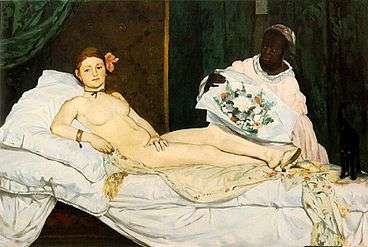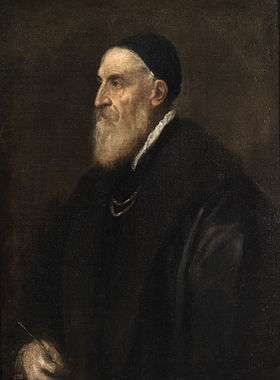Venus of Urbino
 | |
| Artist | Titian |
|---|---|
| Year | 1538 |
| Medium | Oil on canvas |
| Location | Uffizi, Florence |
The Venus of Urbino is a 1538 oil painting by the Italian master Titian. It depicts a nude young woman, identified with the goddess Venus, reclining on a couch or bed in the sumptuous surroundings of a Renaissance palace. It hangs in the Galleria degli Uffizi in Florence. The figure's pose is based on Giorgione's Sleeping Venus (c. 1510), which Titian completed. In this depiction, Titian has domesticated Venus by moving her to an indoor setting, engaging her with the viewer, and making her sensuality explicit. Devoid as it is of any classical or allegorical trappings – Venus displays none of the attributes of the goddess she is supposed to represent – the painting is unapologetically erotic.
Description and history
The Venus stares straight at the viewer, unconcerned with her nudity. In her right hand she holds a posy of roses whilst she holds her other hand over her genitals. In the near background is a dog, often a symbol of fidelity.
The painting was commissioned by Guidobaldo II della Rovere, the Duke of Urbino, possibly to celebrate his 1534 marriage. It would originally have decorated a cassone, a chest traditionally given in Italy as a wedding present. The maids in the background are shown rummaging through a similar chest, apparently in search of Venus's clothes. Curiously, given its overtly erotic content, the painting was intended as an instructive "model" for Giulia Varano, the Duke's extremely young bride.

The model for the painting has been assumed as Angela del Moro, a highly paid courtesan in Venice and a known dining companion of Titian.[1]
The argument for the painting's didacticism was made by the late art historian Rona Goffen in 1997's “Sex, Space, and Social History in Titian’s Venus of Urbino". Titian contrasts the straight lines of the architecture with the curves of the female form, and the screen behind Venus bisects the painting, a large-scale division that is mitigated by unifying elements such as the use of colour and the floral patterns of the couch, cassoni, and background tapestries.
In his 1880 travelogue A Tramp Abroad, Mark Twain called the Venus of Urbino "the foulest, the vilest, the obscenest picture the world possesses". He proposed that "it was painted for a bagnio, and it was probably refused because it was a trifle too strong", adding humorously that "in truth, it is a trifle too strong for any place but a public art gallery".
Inspirations
|
|
The Venus of Urbino was one of the inspirations for Édouard Manet's 1863 Olympia in which the figure of Venus is replaced with the model Victorine Meurent.[2]
References and sources
- References
- ↑ "Titian: His Life" by Sheila Hale, quoted on page 64 of The Economist July 28th 2012
- ↑ Honour, H. and Fleming, J. (2009) A World History of Art. 7th edn. London: Laurence King Publishing, p. 709. ISBN 9781856695848
- Sources
- Berrson, Robert. Responding to Art. Boston: McGraw Hill. ISBN 0-697-25819-X.
- Rosand, David (1978). Titian. Library of Great Painters. New York: Harry N. Abrams; pp. 112–13. ISBN 0-8109-1654-1
External links
- Titian's Venus of Urbino - critical review of the painting
